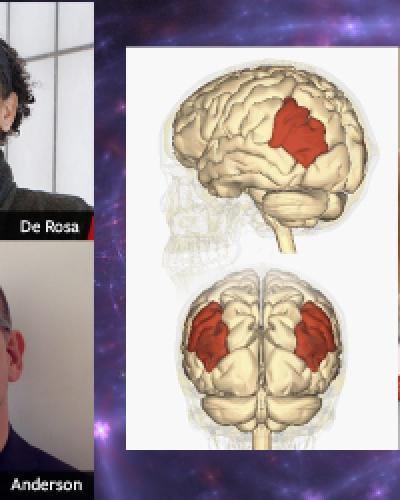The U.S. population is aging at a rapid pace and, as a result, medical experts predict an increase in the diseases associated with aging. By 2050, 13.8 million Americans are predicted to have Alzheimer’s disease – nearly three times the current number – unless there is a medical breakthrough to prevent, slow or cure the disease.
Two brain researchers at the College of Human Ecology are spearheading an effort to develop a non-invasive measurement tool – tracking a person’s heart rate and its variability over time and during cognitive activities – that could provide an early warning sign for dementia.
Adam Anderson, an affective neuroscientist, and Eve De Rosa, a cognitive neuroscientist, both in the Department of Human Development, received a $2.7 million grant from the National Institute of Health to conduct a series of studies that will assess whether the basal forebrain, a portion of the brain crucial to regulating attention and memory, plays a role in age-related declines in both cognition and bodily functions
“The practical problem is how to create accessible, affordable digital biomarkers that can be administered to many people and will predict risk for dementia,” Anderson said. “From a more theoretical perspective, we’re trying to understand the biological mechanisms at work, specifically how the neurochemicals in the brain are affecting both the cardiovascular system and memory. This is not a traditional way to think about things.”
To explore this intersection between the brain, the heart and memory, Anderson and De Rosa have assembled a truly interdisciplinary team of researchers from Cornell, the Center of Excellence for Alzheimer’s Disease at Upstate Medical School, Department of Computer Science at SUNY Binghamton and cardiologists from Weill Cornell Medical School. In addition, they are working with Cornell software engineering and math students to build a smart phone platform that will administer memory tests and track the heart rate of study participants from home.
One focus of the studies is to better understand the role of the neurotransmitter acetylcholine, or ACH, in dementia. Scientists already know that this neurotransmitter helps to control heart rate.
“The place in the brain where ACH is produced is one of the first parts that gets plaques and tangles at the onset of dementia,” De Rosa explained. “When someone is perceived to have dementia, one of the first thing doctors typically do is prescribe a medicine that will help boost ACH in their brain. We know the greater the disfunction in this system, the greater the cognitive impairment. Our goal is to understand the mechanism at work here.”
Their proposal includes two main studies. First, they will conduct a longitudinal study of 150 young, middle-aged and older adults over a three-year period that involves heart-rate monitoring, cognitive tests and brain scans in the Cornell Magnetic Resonance Imaging Facility on the Ithaca campus. “Use of the imaging center is a critical component so that we can measure brain changes over time,” Anderson said.
In addition, they will conduct studies in rats over the course of their lifespans to better understand the brain chemistry at work and investigate the cardiovascular costs of solving cognitive problems. “This type of cross-species translational research is rare,” De Rosa explained. “It will allow us to more fully understand the brain chemistry while we are learning about these mechanisms in humans.”
In the early stages of cognitive decline, most people are able to compensate for the problems they are having, so problems may not show up in typical screening tests. But measuring a patient’s heart rate during these tests may be revealing, Anderson explained.
“What I find fascinating is that our heart responds when we think about things,” he said. “We implicitly understand that if we’re nervous, our breathing increases and our heart rate increases. When you are working on a cognitive problem, your heartrate will change too. You’re doing nothing other than thinking, but it’s reflecting in your body.”
“Say you go in for a neuropsychological assessment and your memory performance looks good,” he said. “Despite your performance being normal, we might be able to see invisible changes in the brain based on how your heart responds. It’s a way of testing that the brain has to work harder to do a specific task.”
Then the question becomes, what do you do if you know you’re at risk for developing dementia? The answer: Exercise more.
“We know lifestyle changes are really powerful for holding back dementia, and especially that exercise enhances cognition,” Anderson said. “We’re doing all of this fancy biology to come around to asking people to do something that we already know is good for them. But giving people insights into their dementia risk may motivate them to make significant lifestyle changes.”
Do cognitive influences on heart rate reflect systemic inflammation, providing an early sign of COVID-19?
When neuroscientists Adam Anderson and Eve De Rosa received a $2.7 million NIH grant to study dementia, they began looking for ways to conduct at least some of the research virtually so they could proceed despite restrictions imposed by the COVID-19 pandemic. They developed the idea of building a smart phone platform to track cognitive performance and heart rate of their study participants, in particular elderly participants, from the safety of home.
Then, as health researchers across the globe learned more about the novel coronavirus, a light bulb went off for the pair: what if their laboratory could use the same platform and digital biomarker as in the dementia study to establish whether someone has been exposed to the coronavirus. The idea is leading to a separate study to find out whether cognitive influences on heart rate reflect systemic inflammation, providing an early sign of COVID-19.
“Many people with COVID-19 are asymptomatic and yet they are able to spread the virus without knowing it,” Anderson explained. “Even though you feel fine, your body is building an immune response that your brain knows about. If we had a digital tool that could identify a drastic change over a few days, it would tell people there was something going on in their bodies. It could help people to understand when to get a nasal swab test or when to quarantine.”
Using this type of affordable, accessible digital tracking could be one way to curtail the spread of the virus.
Anderson and De Rosa are currently working with computer science and engineering students at Cornell to develop a cognitive testing platform for smart phones that simultaneously tracks heart-rate. Their next step will be to distribute to older adults and with pre-existing health conditions who are at higher risk for developing COVID-19. They also plan to use this platform to examine the longer-term consequences of SARS-Cov-2 exposure for brain health.






